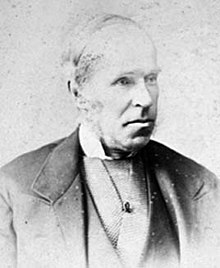John Casey
John Casey (born May 12, 1820 in Coolattin , Ireland , † January 3, 1891 in Dublin ) was an Irish mathematician who is best known for his work on geometry.
Life
John Casey first worked as a teacher at a school in Tipperary, in 1847 he married Catherine Ryan and had four children with her. In 1854 he was appointed principal of a newly opened model school in Kilkenny. There he was introduced to higher mathematics by a former student of Trinity College Dublin and began to communicate about geometric problems with the mathematicians Richard Townswend and George Salmon who worked at Trinity College . They eventually suggested he study at Trinity College for an advanced degree. From 1858 he took courses at Trinity College and graduated in 1862, already during his studies he published several works on geometric topics. After graduating, John Casey worked as a science master in the school sector and was one of the editors of the journal Messenger of Mathematics from 1862 to 1868 . In 1873 both the Catholic University in Dublin and a little later Trinity College offered him a professorship. He canceled the position at Trinity College because he had already given the Catholic University an acceptance and felt bound by it. However, since the Catholic University had too few students at that time to pay him a regular salary, he also worked as a professor at the Civil Service College between 1873 and 1882 and prepared students at the French College for the entrance examination to the Civil Service College. In 1882 he finally became a Fellow of the Royal University (later the National University of Ireland ), which was formed from the Catholic University in 1880, with an annual salary of £ 400.
He was a member of the Royal Irish Academy (1866) and Fellow of the Royal Academy (1875) and received honorary degrees in law from both Trinity College (1869) and the Royal University (1885) . He was particularly fond of the Irish language and therefore a lifelong member of the Gaelic Union and the Society for the Preservation of the Irish Language.
plant
John Casey published over 25 research papers and wrote six textbooks. His annotated edition of the elements of Euclid contained an unusually extensive collection of exercises on geometric problems that he had compiled with Richard Townsend. Most influential, however, proved to be his Sequel to Euclid , published in 1881 , which for the first time compiled all of the more recent results of elementary geometry in the form of a textbook. Together with Émile Lemoine (1840–1912), he was responsible for a revival of interest in elementary geometry (at that time under the title " modern geometry " or " modern triangular geometry "). Today he is best known for an extension of Ptolemy's theorem, which he discovered and which has since been referred to as Casey's theorem .
Books
- On Cubic Transformations (Dublin, 1880)
- A Sequel to the First Six Books of the Elements of Euclid (Dublin, 1881)
- The First Six Books of the Elements of Euclid (Dublin, 1882)
- Treatise on the Analytic Geometry of the Point, Line, Circle and Conic Sections (Dublin, 1885)
- Treatise on Elementary Trigonometry (Dublin, 1886)
- Treatise on Plane Trigonometry containing an account of the Hyperbolic Functions (Dublin, 1888)
- Treatise on Spherical Geometry (Dublin, 1889).
Web links
- John J. O'Connor, Edmund F. Robertson : John Casey. In: MacTutor History of Mathematics archive .
- 1913 Catholic Encyclopedia article on John Casey
| personal data | |
|---|---|
| SURNAME | Casey, John |
| BRIEF DESCRIPTION | Irish mathematician |
| DATE OF BIRTH | May 12, 1820 |
| PLACE OF BIRTH | Coolattin , Ireland |
| DATE OF DEATH | January 3, 1891 |
| Place of death | Dublin |
